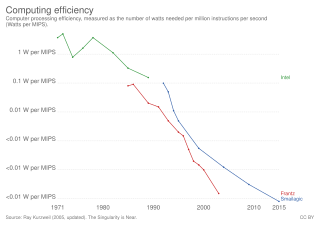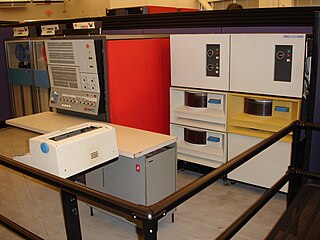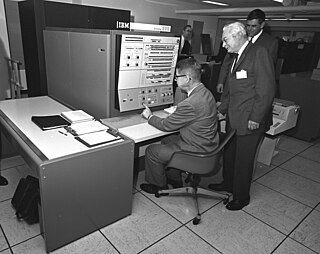
A central processing unit (CPU), also called a central processor, main processor, or just processor, is the most important processor in a given computer. Its electronic circuitry executes instructions of a computer program, such as arithmetic, logic, controlling, and input/output (I/O) operations. This role contrasts with that of external components, such as main memory and I/O circuitry, and specialized coprocessors such as graphics processing units (GPUs).
IBM mainframes are large computer systems produced by IBM since 1952. During the 1960s and 1970s, IBM dominated the computer market with the 7000 series and the later System/360, followed by the System/370. Current mainframe computers in IBM's line of business computers are developments of the basic design of the System/360.

Instructions per second (IPS) is a measure of a computer's processor speed. For complex instruction set computers (CISCs), different instructions take different amounts of time, so the value measured depends on the instruction mix; even for comparing processors in the same family the IPS measurement can be problematic. Many reported IPS values have represented "peak" execution rates on artificial instruction sequences with few branches and no cache contention, whereas realistic workloads typically lead to significantly lower IPS values. Memory hierarchy also greatly affects processor performance, an issue barely considered in IPS calculations. Because of these problems, synthetic benchmarks such as Dhrystone are now generally used to estimate computer performance in commonly used applications, and raw IPS has fallen into disuse.

The IBM System/360 (S/360) is a family of mainframe computer systems that was announced by IBM on April 7, 1964, and delivered between 1965 and 1978. It was the first family of computers designed to cover both commercial and scientific applications and a complete range of applications from small to large. The design distinguished between architecture and implementation, allowing IBM to release a suite of compatible designs at different prices. All but the only partially compatible Model 44 and the most expensive systems use microcode to implement the instruction set, featuring 8-bit byte addressing and fixed point binary, fixed point decimal and hexadecimal floating-point calculations.

The IBM System/370 (S/370) is a range of IBM mainframe computers announced as the successors to the System/360 family on June 30, 1970. The series mostly maintains backward compatibility with the S/360, allowing an easy migration path for customers; this, plus improved performance, were the dominant themes of the product announcement.

The IBM 650 Magnetic Drum Data-Processing Machine is an early digital computer produced by IBM in the mid-1950s. It was the first mass-produced computer in the world. Almost 2,000 systems were produced, the last in 1962, and it was the first computer to make a meaningful profit. The first one was installed in late 1954 and it was the most popular computer of the 1950s.
IBM manufactured magnetic disk storage devices from 1956 to 2003, when it sold its hard disk drive business to Hitachi. Both the hard disk drive (HDD) and floppy disk drive (FDD) were invented by IBM and as such IBM's employees were responsible for many of the innovations in these products and their technologies. The basic mechanical arrangement of hard disk drives has not changed since the IBM 1301. Disk drive performance and characteristics are measured by the same standards now as they were in the 1950s. Few products in history have enjoyed such spectacular declines in cost and physical size along with equally dramatic improvements in capacity and performance.

IBM manufactured and sold document processing equipment such as proof machines, inscribers and document reader/sorters for financial institutions from 1934 to 2005.

The IBM System/360 Model 30 was a low-end member of the IBM System/360 family. It was announced on April 7, 1964, shipped in 1965, and withdrawn on October 7, 1977. The Model 30 was designed by IBM's General Systems Division in Endicott, New York, and manufactured in Endicott and other IBM manufacturing sites outside of U.S.

The IBM System/360 Model 67 (S/360-67) was an important IBM mainframe model in the late 1960s. Unlike the rest of the S/360 series, it included features to facilitate time-sharing applications, notably a Dynamic Address Translation unit, the "DAT box", to support virtual memory, 32-bit addressing and the 2846 Channel Controller to allow sharing channels between processors. The S/360-67 was otherwise compatible with the rest of the S/360 series.
The history of IBM mainframe operating systems is significant within the history of mainframe operating systems, because of IBM's long-standing position as the world's largest hardware supplier of mainframe computers. IBM mainframes run operating systems supplied by IBM and by third parties.
This timeline of binary prefixes lists events in the history of the evolution, development, and use of units of measure which are germane to the definition of the binary prefixes by the International Electrotechnical Commission (IEC) in 1998, used primarily with units of information such as the bit and the byte.

The IBM System/360 Model 40 was a mid-range member of the IBM System/360 family. It was announced on April 7, 1964, shipped in 1965, and withdrawn on October 7, 1977.

The IBM System/360 Model 50 is a member of the IBM System/360 family of computers. The Model 50 was announced in April 1964 with the other initial models of the family, and first shipped in August 1965 to the Bank of America.

The IBM System/360 Model 91 was announced in 1964 as a competitor to the CDC 6600. Functionally, the Model 91 ran like any other large-scale System/360, but the internal organization was the most advanced of the System/360 line, and it was the first IBM computer to support out-of-order instruction execution. It ran OS/360 as its operating system. It was designed to handle high-speed data processing for scientific applications. This included space exploration, theoretical astronomy, sub-atomic physics and global weather forecasting.

The IBM System/360 Model 25 is a low-end member of the IBM System/360 family. It was announced on January 3, 1968, 3 years before the IBM System/360 Model 22, as a "bridge between its old and new computing systems".

The IBM System/360 Model 85 is a high-end member of the System/360 family of computers, with many advanced features, and was announced in January 1968 and first shipped in December 1969. IBM built only about 30 360/85 systems because of "a recession in progress".

The IBM System/360 Model 75 is a discontinued high end/high performance system that was introduced on April 22, 1965. Although it played many roles in IBM's System/360 lineup, it accounted for a small fraction of a percent of the 360 systems sold. Five Model 75 computers housed at NASA's Real Time Computer Complex were used during the Apollo program.

The IBM System/390 is a discontinued mainframe product family implementing ESA/390, the fifth generation of the System/360 instruction set architecture. The first computers to use the ESA/390 were the Enterprise System/9000 (ES/9000) family, which were introduced in 1990. These were followed by the 9672, Multiprise, and Integrated Server families of System/390 in 1994–1999, using CMOS microprocessors. The ESA/390 succeeded ESA/370, used in the Enhanced 3090 and 4381 "E" models, and the System/370 architecture last used in the IBM 9370 low-end mainframe. ESA/390 was succeeded by the 64-bit z/Architecture in 2000.














